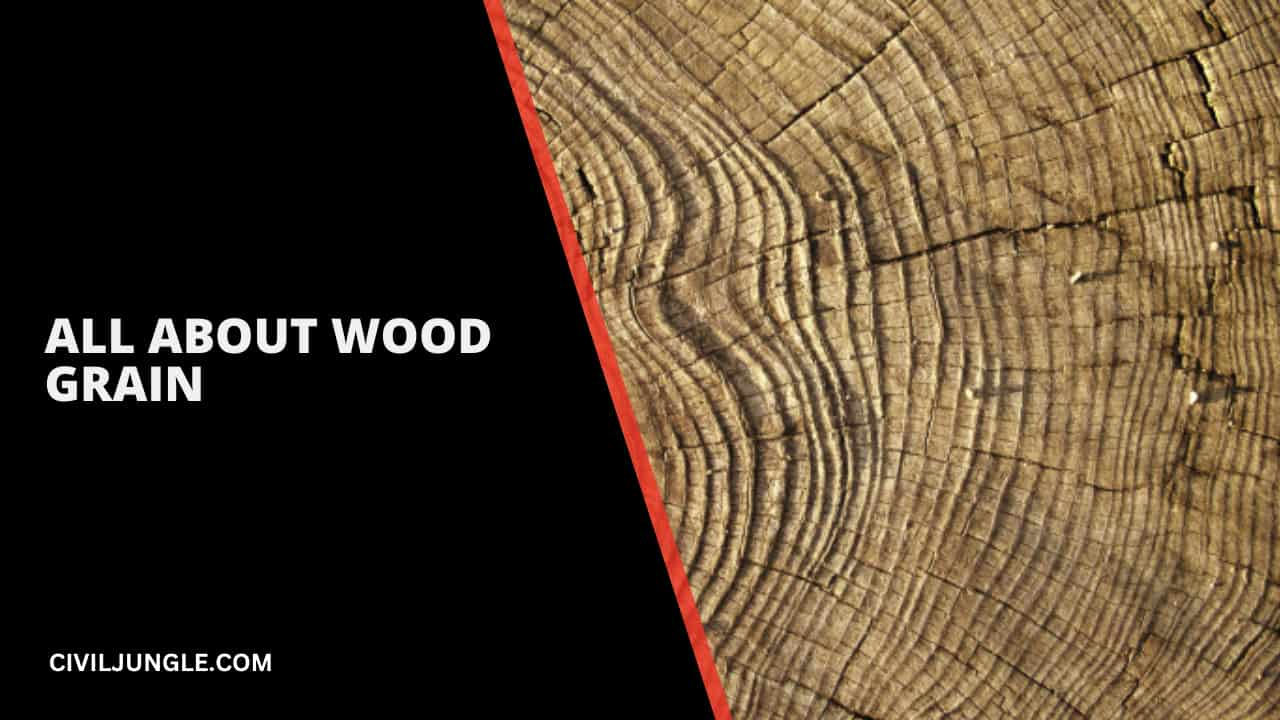
What Is Wood Grain?

The arrangement of wood’s fibers is a result of the growth of the tree, termed wood grain.
A visual pattern is revealed by the fibres at the time of cutting the tree, like lighter or darker wood, called grain Or with more accuracy, the figure.
When a piece of sawn timber is observed, it shows that its texture is also affected by the Woodgrain.
The arrangement, size and type of the fibres affect a piece of sawn wood’s appearance.
Various types of grain patterns are observed by different ways of sawing, with which one of the most common methods being quarter sawing.
In this process, even boards are made by cutting a log which forms parallel plains.
The orientation of cell fibres that run through the piece of lumber is called Wood grain.
If lumber has been observed or a tree trunk has been seen cut, then Wood grain must be found.
Every year when a tree grows, a new line of grain is added to the Wood which is known as the growth ring.
The composition and texture of the Woodgrain are heavily affected by it. Some textures have such a beautiful appearance and one can feel the touch.
There are various types of Wood grain observed by cuts of Wood like an intricate wood grain which is suitable for dining room tables or finished cabinetry on the other hand some cuts are best for traditional lumber.
Wood grain has a deep effect on stains too. Some types possess light and others have a very dark appearance.
Every species of Wood has a unique grain, so to buy the right one you should have to be very sure what is suitable for your project.
Grain plays a vital role in the strength of the wood too so it is another consideration.
A wide range of features is offered as Wood is a fussy material. It is attractive, abundant and very easy to deal with.
If it is maintained properly it can last for many centuries. Many oldest and most popular buildings in the world are made of Wood.
However, Wood is a very perplexing and complex building material that shows a lot of variety.
The Wood cells of a tree are aligned with the limb, trunk and root axis while a tree grows.
Every cell contains very thin and long bundles of fibers.
The fibres are comparatively 100 times longer than wide. Each year while a tree grows annual rings are produced which ultimately make the formation of Woodgrain.
Useful Article For you
- Types of Wood
- What Is Plywood
- Wood Beam Types
- Brands of Plywood
- Is Cedar a Hardwood
- Types of Acacia Woods
- Definition of Sapwood
- Wooden Coffered Ceiling
- Lumber Definition Wood
- MDF Wood Disadvantages
- Types of Wood Construction
- Wood Panel Bathroom Ideas
- Modulus of Rupture of Wood
- Wood Foundation Repair Cost
- What Size Wood for Door Frame
- Attach Wood Fence to Metal Post
- Difference Between Timber and Wood
- Front Porch Flooring Ideas Over Wood
- How Far Apart Should Wood Fence Posts Be
Choosing the Right Grain

Choosing the right grain is an important job. When a Wood is chosen for a custom project few variables like color, species, knot, grain, workability etc. are very important to consider.
If a slab of Wood is selected, especially for a perfectly finished project like a headboard or table, the grain is most important.
Grain and color are one of the most considerable things to make a product like this.
However, grain is far most important than texture as the owner will likely finish and sand.
At the time of cutting the lumber to size and finish, a finished look may be observed.
The strength of the grain to hold the stain must be considered. A marbled and fantastic look will be created by this kind of grain.
An important thing to understand while working with Wood is that grain has texture.
The look and the feeling of lumber are also affected by the texture.
Textures are described by coarse Or fine grain. Fine-grain or coarse-grain are describing the texture.
The arrangement of cells, size and pores makes the difference between fine-grained and coarse-grain wood.
Textures refer to the relative size as well as the amount of variation in the size of the wood.
Rays are called in which way the cells are arranged in bands. Pores also vary in terms of size and distribution.
The above-discussed variables determine whether the wood is considered coarse, fine, or medium-textured wood.
The size of the pores defines the open-grained and close-grained wood.
If there are large visible pores observed while cutting the wood, it is called open grain and on the other hand if there are small pores observed while cutting the wood, known as closed grain.
To fill any gaps, larger open pore lumber with fillers and a smooth finish is created.
To describe the texture some terms like coarse-grained, medium-grained, and fine-grained are used.
The differences in grain are very easy to observe and feel. Hardwood is also referred to by the wood finishers as either close-grained or open-grained.
The size of the pores plays a vital role to determine if a filler is required or not for the surface for smooth finishing or enough sanding.
In the case of hardwood like oak, as it has small tight pores and a good grain so sanding is enough only.
But in the case of wood like pine, as it has bigger pores, it requires some fillers to make it smooth.
Also Read: India No 1 Cement Company
Wood Grain Affects Strength

An additional ring can be observed and felt, added every year while a tree grows.
The number of rings created depends on how slowly the tree grows.
Those trees that grow slowly are much stronger than the trees that grow very fast.
The difference between the trees is well noted when looking at the grain. If the tree grows slowly the grains are tightened and the wood is strong.
The lumber with slow growth especially makes the strongest wood.
The lumber should be considered secure against the grain, which is the most important thing as it adds great strength.
If you go against the grain, it will be so hard to bend but while pressure is put, it is easily bent.
If the wood needs to be curved in any project, it can become very beneficial.
In this type of case, especially to make a circle using this method, the wood must always be installed with the grain.
The orientation of wood fibres determines the pattern of the wood grain.
At the time of growth when the tree produces a new cell, wood grain forms.
The ability to bear or withstand various kinds of impact, weight and stress is called Wood strength.
Wood strength and wood grain are closely related to each other. Wood grain and the way the wood is cut determine the strength of a piece of wood.
In a report, it is found that in every 1000 kinds of trees in America, only 100 of them are strong enough to provide wood that will be helpful for construction purposes.
We can see that the grain may be at about a 90-degree angle if we look at the stamp and can observe that tree rings play a vital role in the tree’s annual growth.
The fibres allow the tree to grow upright by making an alignment vertically up and down the trunk and hence provide a sort of skeleton. To get the maximum strength boards are cut vertically with the grain.
The strongest lumber is produced if the trees grow a bit side-wise. Some trees’ growth pattern has straight and even wood grain that produces good strength and is used in sailing ships sailed as masts.
There can be different growth patterns in a single kind of species because of the environment and as a result, various kinds of wood grain can be produced.
The procedure of cutting the boards from the logs can also make changes in the wood grain.
The board is cut perpendicular to the trunk across the grain in cross-grained boards, for some specific purpose and as a result wood is produced with less strength.
If a log is cut instead of along the length but at an angle to make boards, diagonal grain is formed. Wood strength is reduced if it is cut diagonally across the wood grain.
A 1in the slope of grain like an almost 45-degree angle cut reduces the strength of the wood y means 90 per cent.
There may be almost a seven per cent reduction of wood strength in the case of 1in 20 slopes of grain.
If a tree grows in a twisted way, a spiral grain is formed. There are only a few species that produce twisted growth.
If it twists either left or right across the length of the lig, the spiral is considered consistent.
If the direction of wood fibres changes frequently not more than 45 degrees, then the wavy grain is formed. Very attractive and decorative boards are cut with wavy grain.
If the direction, frequency, and degree of change of wood fibres are not regular, irregular grain is produced.
Fibres around knots are in the examples.
Irregular wood grains are used for decoration purposes and are very attractive.
There can be observed differences in wood strength depending on how the wood grain is placed.
Different types of wood get essential characteristics from annual rings or fine lines that demonstrate growth cycles. They are commonly called wood grain.
Every tree adds growth rings every year, and at last, grain is created by these rings while the wood is cut.
It should be remembered that installing or carving with the grain refers to installing Or cutting in the same direction as the grain.
Opinion from the experts is that at the time of understanding the dynamics of wood grain, it can be crucial to think of petting a dog or a cat. Resistance can occur If carving is done against the grain.
It is because of that the wood will be dug deeper by the cutting tool. In some areas in the U.S. With the short growing season, the tree grows slower and as a result, it will lead to close annual rings.
There are some other areas in southern regions with longer seasons; there are wide annual rings observed.
To prevent the cutting tool from digging deep into the wood, it has to be crucial for cutting with the wood grain.
It’s the cutting tools’ responsibility to find the grain if the wood doesn’t show it.
The wood can be shaved easily if carving is done with grain. If the cutting tool is cut deep into the wood it means the cutting is done against the wood grain.
Types Of Wood Grain
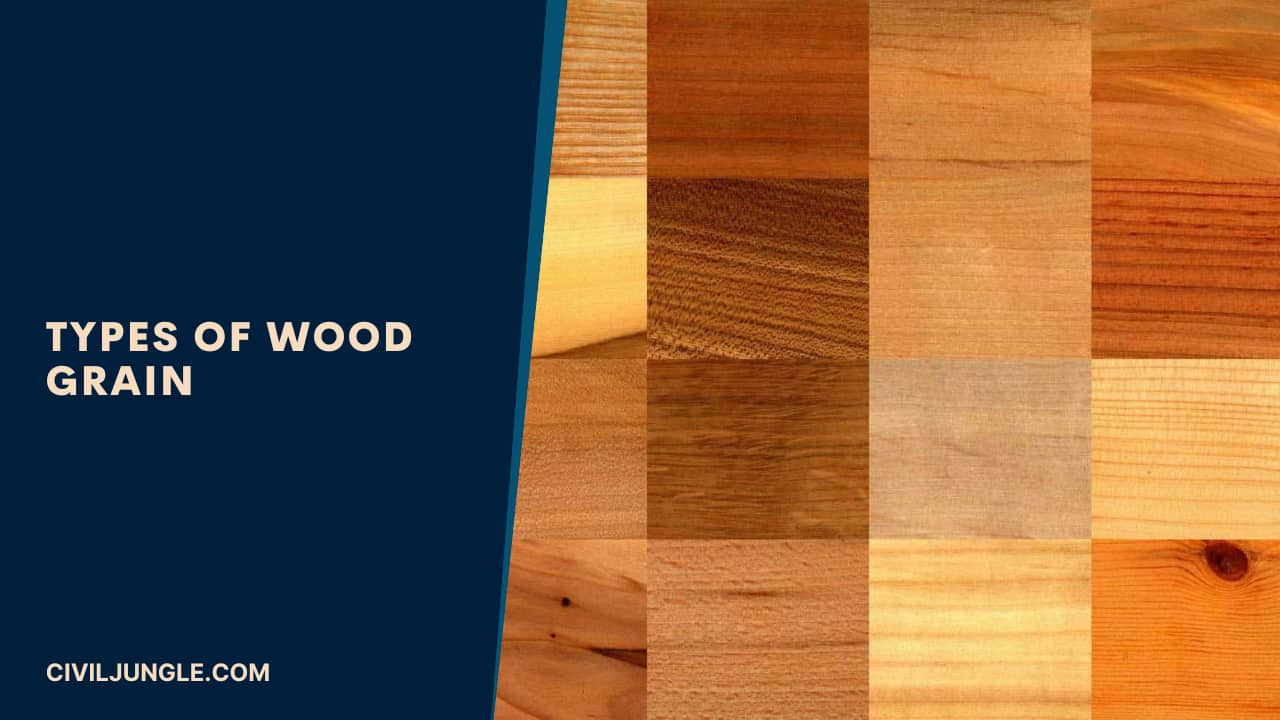
Many elements influence the wood’s appearance, especially the colour pattern and the grain.
Many other characteristics like stains, insect damage, and burls also have the same effect.
There are Some common types of wood grain which are discussed below:
1. Open Grain
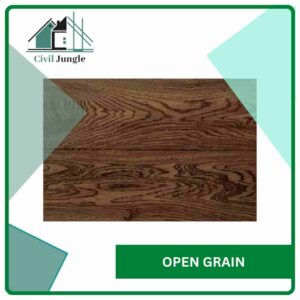
There are some common types of wood like pine, butternut, and oak that have larger pores. These above types are known as open-grain or coarse wood species.
Beech, redwood, white oak, western red cedar, aspen, cypress, poplar etc have straight grain but some other kinds of species have figured grain.
An example of open-grained species of wood is walnut whose grain range varies from straight to pattern. Mahogany is a kind that possesses straight grain but with an unusual pattern that includes stripes, blister and mottle.
In the case of ash, its grain is straight and wide with brown streaks. Last but not least keep in mind that open wood grain makes a unique piece of wood as it has larger grain.
2. Closed Grain

In the case of close grain, it has clustered growth rings and it can take the stains very well by doing it without blotching.
One of the straight grain type wood with little variance in width is alder.
Maple, birch, and rosewood have subtle but straight grains. In hickory, there is a versatile grain that ranges from straight to pattern grain but cherry and poplar have fine, straight grain.
Pine is one of the commonly used woods for furniture and flooring as it has a straight grain.
Researchers find that hardwood possesses closed or open grain.
The wood pores play a vital role to determine the open or closed grain.
There are larger pores in the open grain so that they are easily visible to the naked eye but in closed grain, they have quite smaller pores, so they make a smooth surface and are suitable and preferable for interior decoration.
3. Figured Grain
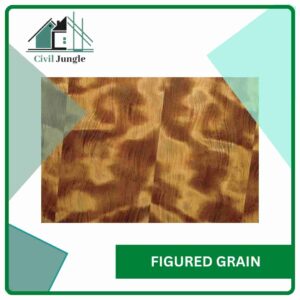
To enhance the wood quality, figured wood should be used as per the expert’s opinion.
It should be remembered that specifically figured grains aren’t found in one tree type.
figured grains are not specific to one tree type. By using the figured grain type of wood, the work of the project will be more beautiful and can get a unique touch.
It has been noticed that a large number of ripples are arranged in series on fiddle back wood and hence making it unique.
For construction purposes of violin backs, fiddle back wood is recommended.
Spalted wood with black streaks is formed by microbes and fungi which run through different patterns.
There can be found some other kinds of woods with crotch, silver, burl, ribbon, and curly figures.
Crotch wood is formed when a tree of a large branch meets with another tree trunk and thus produces remarkable twirls and swirls in wood.
4. Exotic Grain
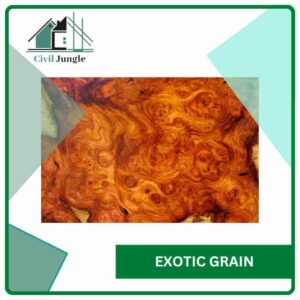
Unusual grain patterns with some exotic characteristics are observed in some wood.
In zebrawood, there are broad dark lines and sometimes within swirling dark lines and it is an exotic wood type.
Lacewood, which is an Australian-based wood, possesses grain resembling hammered copper. Tigerwood which is a South American-based wood possesses a dark orange appearance and also has stripe grain hence by giving a unique look, it resembles tiger stripes.
However, there is a deep orange appearance in cocobolo wood with a black stripping grain.
Another example of exotic wood is Teak wood which has a straight grain and thus makes it more beautiful to use in outdoor furniture as it has very resistant properties which help to withstand bad weather conditions.
Also Read: How to Calculate Quantity of Steel
How Wood Grain Is Created?
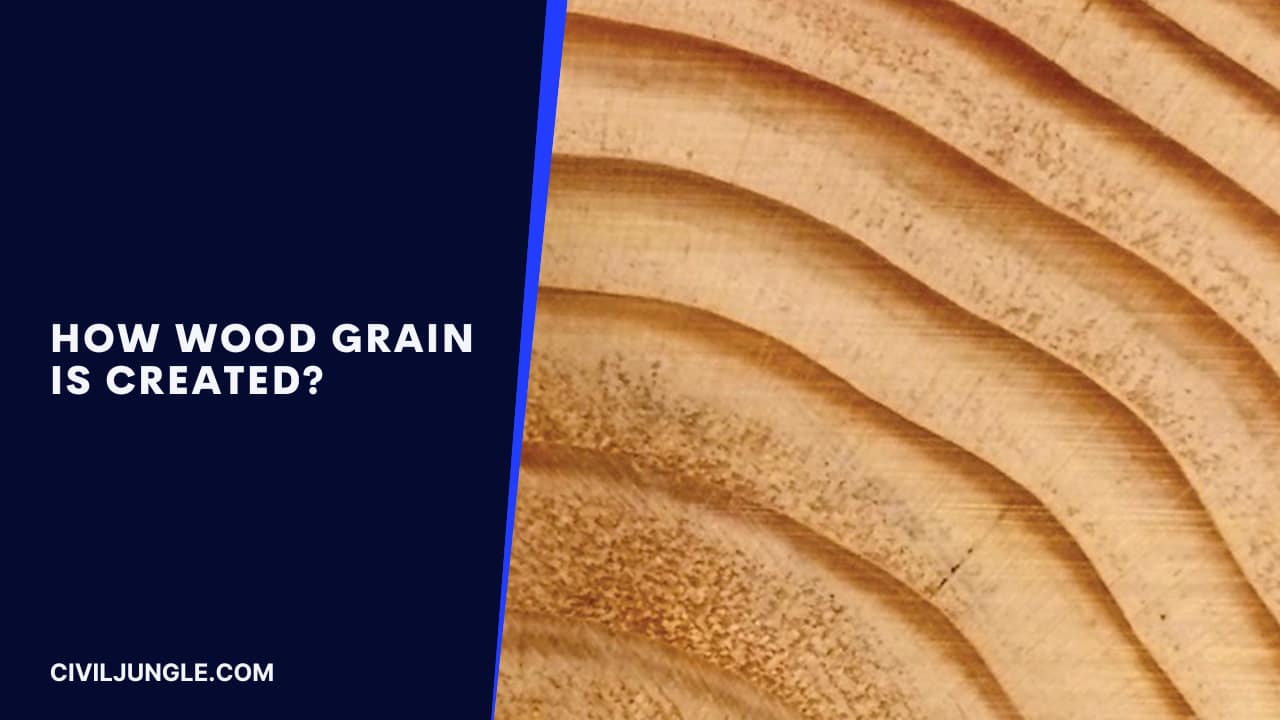
Trees have a very complex structure that changes when it grows as it is a living structure. If the grain of a tree is examined, the life of the tree can be well explained.
If the cells are aligned with the root, tree trunk or limb axis, wood grain is formed.
Two types of wood cells are generated when a tree cambium grows in this process. Many of the cells possess narrow, longitudinal and longer structures.
After the alignment of the cells with the tree trunk axis, wood grain is formed. Pith is the area in the centre of a tree trunk, which is very soft.
Besides the surrounding areas, there are some different colouring areas, called heartwood.
Especially dead cells that make heartwood and give support to the tree.
Then comes the sapwood which is a layer of wood that carries minerals, sugar and water between the leaves and roots.
The colour of Sapwood is mainly lighter than that of heartwood. After it, there is the cambium, which is outside of sapwood and is under the bark and very close to the surface.
When the tree grows, new wood is manufactured by the thin layers of living cells that make the cambium. Light-coloured springwood is created as there is a fast growth of the cambium in spring.
When the temperature is warm, the growth of cambium slows down and as a result, dark summer wood is produced.
From cold weather to spring, cambium remains dormant and a growth ring is produced by this cycle.
Also Read: Process of Constructing a Building
Wood Grain Direction

Two types of cells are created at the time of growth of the cambium. Most of them run along the axis and are narrow long cells.
Their direction is circular and is responsible for forming wood grain.
A few ray cells are produced by the cambium which has an extension from the pith.
Rather than running in a circle, they are mostly perpendicular to the axis.
Across the circular cells, the ray cell is cut that extends to the bark of the tree from the centre.
Protoplasm dies inside the cell when the tree grows and is left behind the cell walls.
Wood gets strength from these walls which are mainly cellulose fibres. If the trunk is observed after cutting the tree it will be seen there are mostly cell walls.
It lies under the bark and is the outer edge which is alive and keeps growing.
To hold the fibres together we have to use lignin which is a glue-like substance.
Hollow cells that run through the tree are responsible for carrying sap down and up the trunk and also throughout the branches and thus store plant sugars.
Gradually the sapwood turns into heartwood while the sap dry, extractive which are mineral compounds, forms on the cell walls.
For changing the wood’s colour those compounds are responsible which making it darker and giving it the required colour of its species.
Various types of species are there, some are dark brown, some yellow, greenish, red, gold etc. Durability, hardness and strength are also affected by the extractive compounds.
What Is End Grain Wood?
End, edge and face grain refer to the different sides of a wooden board. End grain is the narrow, porous top and bottom edge of the board. The rings of the trees growth are sometimes visible in stack, parallel, curved lines.
What Wood Has the Best Grain?
Lignum vitae, a hardwood native to the West Indies, has the finest-grain of any wood known and an ironlike density. A cubic foot of it, air-dried, weighs about 83 pounds-so heavy that it won’t float.
What Is Open Grain Wood?
Open-grained and close-grained wood refers to the size of the pores; woods with large visible pores are ‘open-grain’, and those with pores too small to see clearly are ‘closed-grain’. When the wood’s sawn, large pores can split and this will decide whether timber needs a filler to achieve a smoother finish.
What Does Ash Wood Grain Look Like?
Ash is a light colored, smooth-grained hardwood that grows throughout the east coast and parts of Canada. With its typical straight grain and beige-to-light-brown hue, ash wood is a very attractive option for fine furniture.
What Is the Grain of the Wood?
Technically ‘wood grain’ refers to the alignment, texture and appearance of wood fibres, whereas it’s ‘figure’ describes the pattern created by the grain orientation. Basic grain descriptions and types include: Straight-grain: this runs in a single direction along the cut wood.
What Is Closed Grain Wood?
Hardwoods can be either open grain or closed grain. It’s the wood pores that determined if it’s open or closed grain. Larger pores are considered open grain and are visible to the naked eye. Smaller pores create a closed grain. Closed grain wood has a smoother surface.
What Wood Has the Least Amount of Grain?
Softwoods do not have pores. Their appearance is down to colour differences between the springwood and the summerwood, which are parts of wood in the tree’s growth rings. As a result, they tend to have less prominent, lighter grains. Softwoods can grow faster, which results in a wider grain pattern.
What Is Edge Grain Wood?
Edge grain shows you the wood cut along the edge and with the grain. Edge grain butcher block is usually made of strips of wood that can be lined up evenly or assembled in a pattern that resembles a hardwood floor.
Types Of Wood Grain
There are three different types of wood grains depending on the way to cut and slice the wood; flat grain(F), straight grain(S), and curly grain(C). Therefore, even within a same wood species, the grain types will vary depending on how it is cut and sliced.
6 Types of Wood Grain
Different wood grain descriptions: straight, irregular, interlocking, wavy, spiral. Wood enthusiasts, architects and designers often use certain labels to describe a wood’s grain.
Wood Grain Pattern Types
- Open Grain.
- Closed Grain.
- Flat Grain.
- Curly Grain.
- Straight Grain.
- Interlocked Grain.
- Irregular Grain.
- Live Sawn: Vertical Grain.
Closed Grain Wood List
Examples of closed grain woods are Cherry, Maple, Birch, and American Black Walnut.
Identifying Different Wood Grains
Softwoods usually have smooth grain patterns, while hardwoods have rougher, more porous patterns. Look at the grain and feel it with your fingertips to determine if it has the texture of a hardwood. Hardwoods come from flowering trees like walnuts, oak, and maple.
Plywood Grain Direction
During this manufacturing process the mills will lay the grain of the ply sheets in alternating directions. In higher quality plywood like that supplied by Global Panel Products, the grain is laid running at a right angles (45 degrees) to the adjacent layer.
Wood Grain Direction for Strength
Wood moves more across the grain than along it. Wood has more strength along the grain than across it.
Grain of Wood Direction
(Wood) In wood, grain direction refers to the longitudinal, or vertical, axis of the trunk, along which the structural cells are elongated (Cronyn 1990). It is the texture seen on the cut surface of a piece of wood.
Wood Turning Grain Direction
What is the bowl turning grain orientation of the wood used to turn a wooden bowl? The bowl turning grain orientation for most wood bowls is a side-grain orientation. However, end-grain bowls, less common than side-grain bowls, can be turned from a raw log as well.
Wood Grain Strength Direction
The strength axis (also called major axis) is the direction parallel to the grain of the wood fiber in the face and back surfaces of the panel. This is generally the long dimension of the panel, unless the markings on the panel indicate otherwise.
Like this post? Share it with your friends!
Suggested Read –

